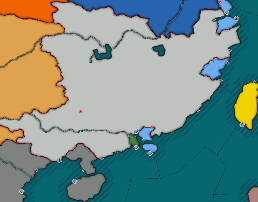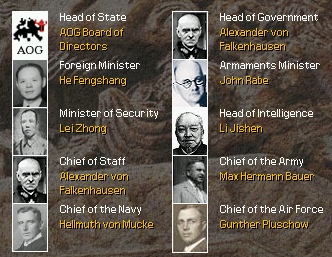Allgemeine Ostasiatische Gesellschaft
From Kaiserreich
| ||||
| Motto Gott mit Uns (God with us) | ||||
| Anthem Heil Dir im Siegerkranz | ||||

| ||||
| Official Language | German | |||
| Capital | Guilin | |||
| Head of Government | Alexander von Falkenhausen, assisted by a Board of Directors | |||
| Establishment - Treaty of Nanjing | October, 27 1926 | |||
| Government | Autonomous territory under unlimited and exclusive economic exploitation from the German Empire | |||
| Currency | East Asian Papiermark | |||
| Area | 1.202.400 km² | |||
| Population | About 150 millions | |||
Algostasien GmbH, or officially Allgemeine Ostasiatische Gesellschaft (German for General East Asian Company)is a country in Asia.
Contents |
History
German colonization in China
In 1891 the Qing government decided to make the area of Tsingtao (also known as Qingdao) a defense base against naval attack and eventually began to improve Tsingtao’s existing fortifications. This Chinese activity was observed and reported by German naval officials during a formal survey of Kiautschou Bay in May 1897. After the Kiautschou Bay region was ceded to Germany in April 1898, the German authorities soon turned the impoverished fishing village of Tsingtao into a strategically important port administered by the Imperial Department of the Navy (Reichsmarineamt) rather than the Imperial Colonial Office (Reichskolonialamt). The navy based their Far East Squadron here, allowing the ships to conduct operations throughout the Pacific. The German imperial government planned and built the first streets and early infrastructure of the city (still visible today), introduced electrification throughout, a sewer system and a safe drinking water supply. German influence extended to other areas of Shandong Province, including the establishment of diverse commercial enterprises, especially in Yantai.
During the Weltkrieg, German's possessions in China were occupied by Japan, but the Peace with Honour restored German rule in 1921. A separate agreement between Germany and China placed Tangshan, located north of the port of Tianjin, under German control. Tangshan is an important heavy industry city and is also known as "the capital of porcelain in north China".
The 1926 Intervention
Establishment of the Algostasien GmbH
Politics
|
Governor-General and Chief of Staff of the German Colonial Forces: Alexander von Falkenhausen (born 29 October 1878)
Secretary for Relations with the German Empire: He Fengshang (born 10 September 1901)
Secretary for Economic Relations with Germany: John Rabe (born 23 November 1882)
Secretary for Internal Security: Lei Zhong
Secretary for Special Intelligence: Li Jishen
Commander-in-Chief of the Colonial Ground Forces: Max Hermann Bauer (born 31 January 1869)
Commander-in-Chief of the Colonial Navy: Hellmuth von Mücke (born 25 June 1881)
Commander-in-Chief of the Colonial Air Force: Günther Plüschow (born 8 February 1886)
Military
Army
Air Force
Navy
Foreign relations
Culture
|



